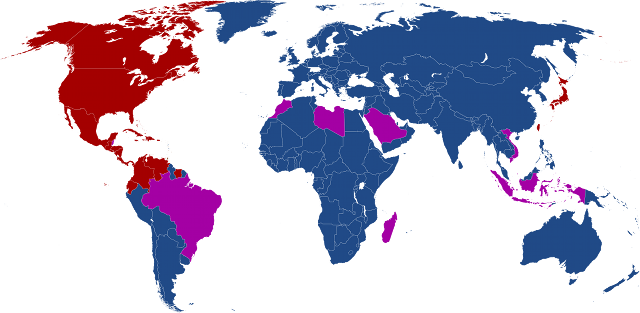I saw a tweet recently that intrigued me:
http://twitter.com/#!/yoz/status/191445005414567937
The voltage of mains electricity varies from country to country: the majority of countries use between 200 and 240 volts, but a small minority (most notably the US, Canada and Japan) use between 100 and 127 volts.

Countries using 100-127 volts are shown in red; countries using 200-240 volts are shown in blue. Countries with a mixture of the two systems are shown in purple.
The voltage* of an electrical supply is what pushes electrons around in a circuit. The higher the voltage, the faster the electrons move and thus the higher the current (one amp is equivalent to about six billion billion electrons flowing past a point per second). With a low voltage the rate of transfer of electrical energy is therefore much slower. In the UK, with a mains voltage of 230 V and a limit of 13 A per socket the maximum possible power to one appliance is 2990 watts (2990 joules per second). In the USA, with a mains voltage of 120 V and a limit of 15 A per outlet the maximum possible power is reduced to only 1800 watts, which is why in the US many large appliances (e.g. washing machines, tumble dryers) have to be connected to a separate high-voltage circuit.
To raise the temperature of one litre of water from 15°C to boiling at 100°C requires a little bit over 355 kilojoules of energy. An “average” kettle in the UK runs at about 2800 W and in the US at about 1500 W; if we assume that both kettles are 100% efficient† than a UK kettle supplying 2800 joules per second will take 127 seconds to boil and a US kettle supplying 1500 J/s will take 237 seconds, more than a minute and a half longer. This is such a problem that many households in the US still use an old-fashioned stove-top kettle.
* As a physicist I would normally use the term “potential difference” in place of “voltage” but voltage is better understood by the general public. Looks like the engineers (who prefer “voltage”) won that battle.
† As electric kettles actually use the joule heating effect that is responsible for most of the energy wasted in other electrical devices this isn’t a terribly unfair assumption.